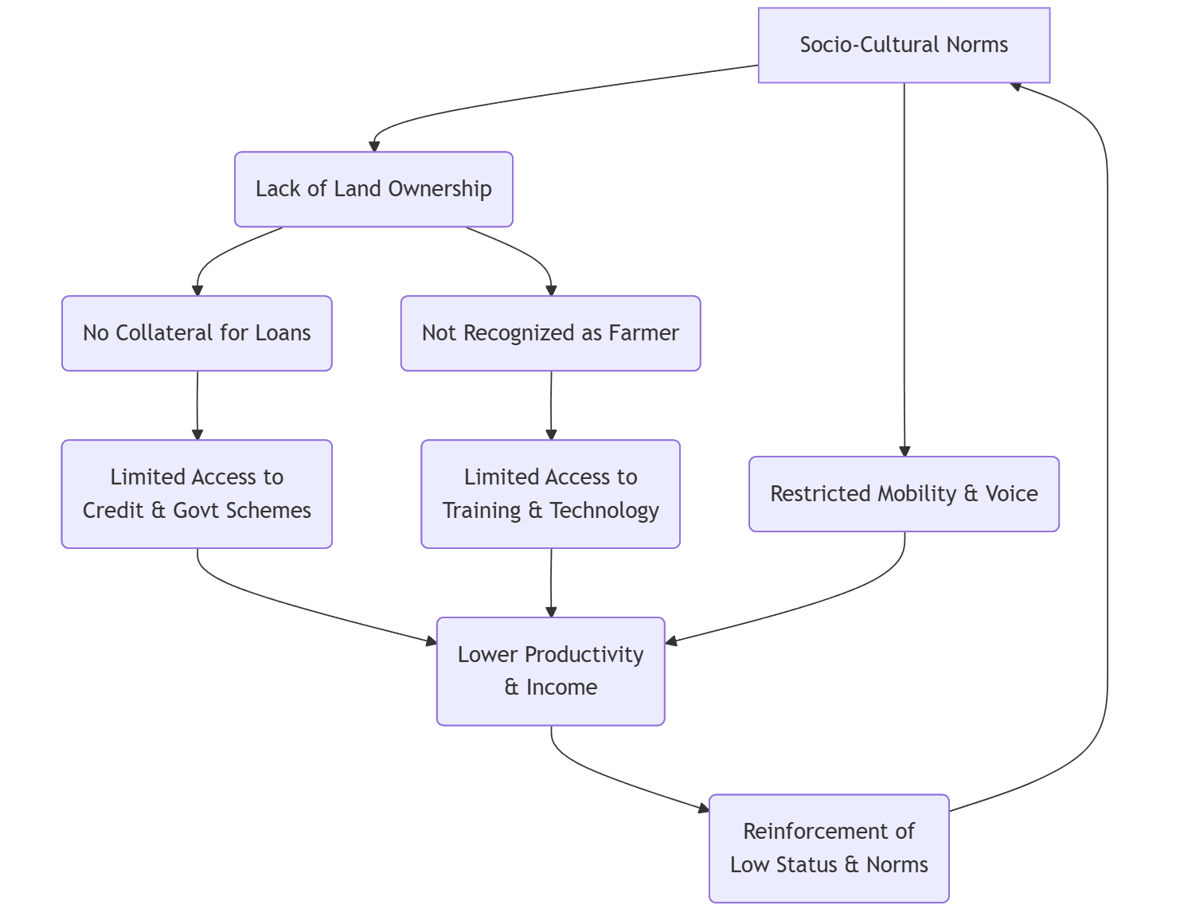Social Justice
Empowering Women in Agriculture
- 01 Oct 2025
- 8 min read
For Prelims: Periodic Labour Force Survey (PLFS), Mahila Kisan Sashaktikaran Pariyojana, Kisan Credit Cards, Tea, Coffee, Gram Panchayats, Cooperatives, Farmer Producer Organizations, BHASHINI, Digital Sakhi, e-NAM.
For Mains: Status of Feminisation of Indian Agriculture, Challenges in Women's Agricultural Empowerment, Systemic Barriers to Women's Progress, Government Initiatives for Women Farmers, Strategies for Future Empowerment.
Why in News?
As per the Periodic Labour Force Survey (PLFS) 2023-24, women’s participation in agriculture has increased significantly, however, nearly half of them continue to remain unpaid, reflecting deep-rooted gender disparities in farm employment.
What is the Status of Women in Agriculture Across India?
- Feminisation of Agriculture: Women now make up over 42% of India’s agricultural workforce, a 135% increase in the past decade. Two out of three rural women work in agriculture.
- Prevalence of Unpaid Work: Nearly half of women in agriculture are unpaid family workers, rising from 23.6 million to 59.1 million over eight years (2017-18 to 2024-25).
- Regional Concentration: In states like Bihar and Uttar Pradesh, more than 80% of women workers are in agriculture, however, over half remain unpaid.
- Government Support: Mahila Kisan Sashaktikaran Pariyojana, Kisan Credit Cards, and Self-Help Groups collectively empower women farmers through skill development, access to formal credit, sustainable agriculture, and strengthened collective bargaining.
What Factors are Leading to Feminisation of Agriculture in India?
- Male Out-Migration: Men are migrating to cities or shifting to more lucrative rural jobs (construction, services, transport, government), leaving women to manage and work on family farms.
- Growth of the Contract Farming: Sectors like floriculture, horticulture, and tea/coffee plantations prefer women for labor-intensive tasks, viewing them as reliable, skilled, and willing to accept lower wages.
- Patriarchal Norms: Society expects women to handle home and light farm work, treating their farm labor as part of household duties or assisting men.
- Limited Alternative Opportunities: Lower literacy, restricted mobility, and social norms limit women's non-farm employment, making agriculture one of the few acceptable and accessible livelihoods in rural areas.
What are the Systemic Barriers Limiting Women’s Progress in Agriculture?
Mnemonic: WOMEN
- W - Wage Discrimination: Women in India earn 20-30% less than men, highlighting gender wage gaps and economic inequality, which limit economic empowerment.
- O - Omission from Decision-Making: Agricultural extension officers are predominantly male, excluding women from knowledge on seeds, pesticides, and sustainable practices, while their opinions are often overlooked in Gram Panchayats and farmer cooperatives.
- M - Machinery and Tool Mismatch: Farm machinery such as tractors, harvesters, and threshers is designed for male physiques, while women often lack the strength, training, or financial means to operate or access it.
- E - Entrenched Domestic Double Burden: Restricted mobility and time poverty from domestic chores, and childcare limit women’s access to markets, skill development, and community participation.
- N - Negation of Land and Identity Rights: Women own only 13-14% of land holdings, and without land titles, they are seen as cultivators rather than farmers, limiting access to credit, government schemes, and independent decision-making.
What Measures can Effectively Ensure the Empowerment of Women Farmers in India?
Mnemonic: GROW
- G - Guarantee Market Access: Free Trade Agreement (FTAs) like the one with the UK, expected to raise agricultural exports by 20%, should focus on women-intensive sectors such as tea, spices, and dairy, and support women in exporting premium products like organic foods and GI-tagged goods, using their traditional knowledge.
- R - Resource Rights and Reforms: Promote joint or individual land ownership for women to enhance access to credit, insurance, and government support, and systematically scale proven women-led Farmer Producer Organizations (FPOs) and SHGs to achieve economies of scale.
- O - Open Digital Gateways: Scale up digital platforms like e-NAM, promote voice-first AI like BHASHINI, Jugalbandi, and Digital Sakhi for digital and financial literacy.
- W - Well-being and Social Support: Provide creche facilities near farms, water supply, and clean energy to reduce women’s time poverty, while using media campaigns and awards to brand women farmers as role models.
Conclusion
To harness the potential of feminising agriculture, India must transition from recognizing women's labor to empowering them as economic agents. This requires dismantling systemic barriers like land rights denial and wage gaps, while actively promoting their access to technology, markets, and decision-making roles for inclusive growth.
|
Drishti Mains Question: Q. "The feminisation of agriculture in India has reinforced existing inequities rather than empowering women." Critically examine this statement and suggest measures for a gender-inclusive agricultural growth model. |
Frequently Asked Questions (FAQs)
1. What is Feminisation of Agriculture?
Ans: The feminisation of agriculture refers to the increasing participation of women in agricultural labor due to the migration of men to non-farm jobs.
2. What is the current share of women in India’s agricultural workforce?
Ans: Women now constitute over 42% of India’s agricultural workforce, marking a 135% increase in the past decade.
3. Which factors are driving the feminisation of agriculture in India?
Ans: Male out-migration, growth of contract farming, patriarchal norms, and limited non-farm opportunities for women are key drivers.
UPSC Civil Services Examination, Previous Year Questions (PYQs)
Prelims:
Q. With reference to the circumstances in Indian agriculture, the concept of “Conservation Agriculture” assumes significance. Which of the following fall under the Conservation Agriculture? (2018)
- Avoiding the monoculture practices
- Adopting minimum tillage.
- Avoiding the cultivation of plantation crops
- Using crop residues to cover soil surface
- Adopting spatial and temporal crop sequencing/crop rotations
Select the correct answer using the code given below:
(a) 1, 3 and 4
(b) 2, 3, 4 and 5
(c) 2, 4 and 5
(d) 1, 2, 3 and 5
Ans: (c)
Mains:
Q. Discuss the various economic and socio-cultural forces that are driving increasing feminization of agriculture in India. (2014)







